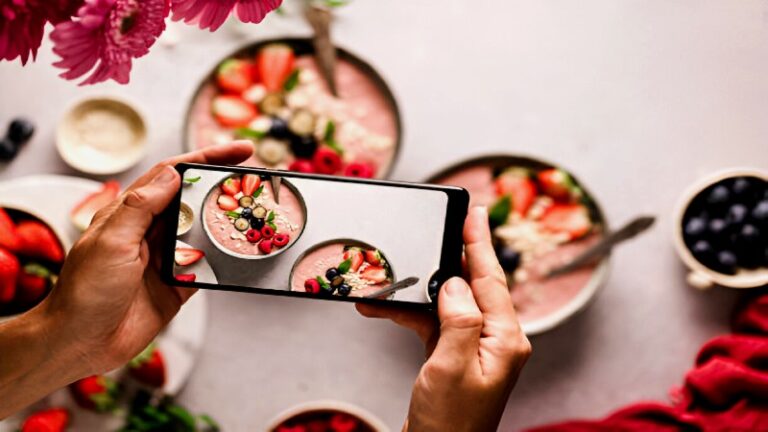In a world where every meal can be a visual story, mastering food photography 101 isn’t just a skill—it’s a superpower for anyone from home cooks to restaurant owners. The tantalizing gleam of a perfectly cooked steak or the vibrant hues of a fresh salad can speak volumes, often more effectively than words. As Calum Ward of CJ Digital, a successful restaurant marketing agency, keenly observes, Stunning visuals on platforms like Instagram and Facebook have become indispensable tools for attracting hungry patrons and creating a buzz around your culinary offerings.
In essence, captivating food photography is about making your audience’s taste buds tingle just by looking at your images. It’s the difference between a casual snap and a meticulously crafted visual that sparks desire and tells a compelling story. This goes far beyond just good lighting; it’s about composition, styling, and understanding the emotional connection people have with food. Whether you’re a passionate home chef sharing your daily creations or a restaurant aiming to fill seats, elevating your food photography game is a fundamental step towards professional-level presentation.
Elevating Your Viewpoint
While traditional food photography often focuses on overhead or 45-degree shots, achieving a truly fresh perspective means understanding the emotional angle your dish evokes. It’s about more than just showing the food; it’s about conveying the experience. This emotional angle involves asking: What feeling does this dish inspire? Comfort? Celebration? Refreshment?
Consider these unique approaches to your visual storytelling:
- The Deconstructed Story: Instead of just the finished dish, show one key ingredient in focus with the partially assembled dish blurred in the background. This builds anticipation and highlights freshness.
- The Before & After Tease: A subtle two-panel shot, one showing key raw ingredients artfully arranged, the other the finished culinary masterpiece. This tells a complete journey from raw potential to delicious reality.
- The Human Element, Subtly: Beyond just a hand reaching for food, consider a blurry reflection of a joyful face in a polished spoon, or the soft focus on steam rising with a warm glow on a person’s face slightly out of focus. This connects the viewer to the experience without distracting from the food.
- The Dynamic Motion Blur: For dishes with movement (e.g., pouring sauce, sprinkling herbs), experiment with a slightly slower shutter speed to create a subtle motion blur around the moving element, drawing the eye directly to the action and freshness.
Essential Pillars of Professional Food Photography
To consistently capture stunning culinary visuals, certain fundamental principles must be mastered. These are the building blocks of impactful food photography, regardless of your equipment.
Mastering Composition & Storytelling
Composition isn’t just about the rule of thirds; it’s about guiding the viewer’s eye and telling a story. Goose Box, a catering company in London, exemplifies this mastery, where every photo looks meticulously crafted.
- Rule of Thirds Reinvented: Place key elements (the hero dish, a unique garnish) at the intersections of imaginary lines, but also explore intentional off-centering or negative space to create drama.
- Leading Lines: Use cutlery, napkins, or even the arrangement of ingredients to draw the eye towards your main subject.
- Depth of Field: Experiment with shallow depth of field to beautifully blur backgrounds, making your dish pop, or a larger depth of field to showcase an entire spread.
| Composition Technique | Benefit for Food Photography | Best For |
| Rule of Thirds | Creates dynamic, balanced images | Most dishes, especially hero shots |
| Leading Lines | Guides the viewer’s eye to the main subject | Table settings, multi-dish spreads |
| Shallow Depth of Field | Emphasizes the main dish, blurs distractions | Close-ups of textures, single servings |
| Negative Space | Creates a clean, elegant focus on the food | Minimalist presentations, artistic shots |
The Power of Natural Light
Food photography always emphasizes natural light as your ultimate ally. It enhances colors and textures authentically without the harshness of direct flash or overhead artificial lights.
- Window Light: Position your food near a window, ensuring the light comes from the side or slightly behind the dish for dimension and texture.
- Diffused Light: If the sunlight is too strong, use a sheer curtain, baking paper, or a translucent diffuser between the window and your food to soften the light and prevent harsh shadows.
- Reflectors & Fill Light: A simple white foam board or a piece of white cardstock can bounce light back onto the shadowed areas of your dish, opening up details without creating new shadows.
Strategic Styling & Prop Selection
Food styling transforms a plate of food into a visual masterpiece. It’s about presentation, texture, and subtle cues that invite the viewer to imagine the taste.
- Freshness First: Always use the freshest ingredients. A wilted herb or dull fruit can instantly detract from your image.
- Less is More: Avoid over-cluttering the plate or the scene. Allow the food itself to be the star.
- Contextual Props: Choose props that tell a story without overwhelming the dish. A rustic wooden board for bread, a vintage spoon for soup, or a sprig of the herb used in the dish can add authenticity.
- Texture & Garnish: Think about how garnishes add texture and a pop of color. A sprinkle of fresh herbs, a dusting of powdered sugar, or a swirl of sauce can elevate the dish. Remember Mr. Steak’s focus on their wow factor steaks; the presentation complements the hero.
Essential Gear & Post-Processing Finesse
While your smartphone can capture great shots, investing in quality equipment and understanding post-production can truly take your photography skills to a professional level.
Smart Equipment Choices
You don’t need the most expensive gear to start, but understanding the basics helps:
- Camera: A modern smartphone often suffices for social media. For higher quality, consider a DSLR or mirrorless camera with a versatile lens (e.g., a 50mm prime lens is excellent for food).
- Tripod: Essential for sharp images, especially in lower light or when working with longer exposures. It also frees up your hands for styling.
- Diffuser & Reflector: Inexpensive yet incredibly effective tools for controlling natural light.
The Magic of Editing
Post-production isn’t about creating something fake; it’s about enhancing the natural beauty you’ve captured.
- Consistency: Maintain a consistent editing style that aligns with your brand.
- Enhance, Don’t Over-Edit: Adjust colors, contrast, brightness, and sharpness subtly. Tools like Adobe Lightroom or VSCO offer powerful features.
- White Balance: Correcting white balance is crucial to ensure colors are true-to-life and appetizing. Avoid overly warm or cool tones unless intentionally going for a specific mood.
The Human Touch
Beyond the technicalities, truly compelling food photography often incorporates a human element. This doesn’t necessarily mean a face in every shot, but rather a hint of interaction that makes the viewer feel connected.
- In-Action Shots: A hand sprinkling salt, a fork poised to scoop, or a knife slicing through a perfectly baked pie can add dynamism and relatability.
- Behind-the-Scenes Authenticity: Show glimpses of the cooking process, the raw ingredients, or the chef’s hands at work. This builds trust and tells a story, humanizing the culinary journey.
- User-Generated Content (UGC): Encourage customers to share their dining experiences using a branded hashtag. Reposting this content not only provides diverse visuals but also creates a community around your brand, adding a layer of authentic social proof.
Conclusion
Mastering food photography is an ongoing journey of observation, experimentation, and storytelling. It’s about more than just taking pictures; it’s about crafting a visual feast that evokes emotion, sparks curiosity, and ultimately, drives desire. By applying the principles of intentional lighting, thoughtful composition, strategic styling, and a touch of human connection, you can transform your culinary creations into professional-grade visual assets. This dedication to visual excellence will not only elevate your online presence but also leave a lasting, mouthwatering impression on everyone who encounters your delicious work.
Frequently Asked Questions (FAQs)
What is the most important element in food photography?
Natural light is often considered the most crucial element in food photography, as it enhances colors, textures, and the overall vibrancy of a dish most effectively.
Do I need a professional camera for good food photography?
While professional cameras offer superior quality, a modern smartphone can capture excellent food photos, especially when paired with good lighting and composition techniques.
What is composition in food photography?
Composition refers to the arrangement of elements within your frame, including the food, props, and background. Techniques like the Rule of Thirds and leading lines guide the viewer’s eye and tell a visual story.
How can I make my food look more appealing in photos?
Focus on using fresh ingredients, simple and clean styling, selecting complementary props, and ensuring good lighting to highlight textures and colors. Subtle garnishes also make a big difference.
Why is post-processing important for food photos?
Post-processing helps refine your images by enhancing colors, contrast, and sharpness, correcting white balance, and ensuring a consistent look that aligns with your brand’s aesthetic.
What is a fresh perspective in food photography?
A fresh perspective goes beyond basic shots, focusing on conveying the emotional essence or story of a dish, using techniques like deconstructed views, subtle human elements, or dynamic motion blur.
How does user-generated content help food photography?
User-generated content provides authentic visuals from customers’ perspectives, builds community, and offers social proof, making your brand more relatable and trustworthy online.


